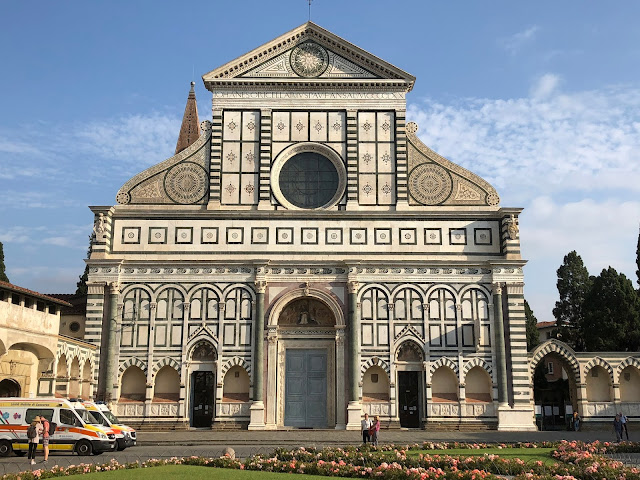【フィレンツェ】サンタ・マリア・ノヴェッラ教会とアルベルティ Firenze - Santa Maria Novella & Alberti
サンタ・マリア・ノヴェッラ教会のファサードは、実に美しい。
このファサードは、アルベルティが設計したものと言われ、ルチェッライ家がその資金を提供し、1470年に完成された。
大理石の白い色と、象嵌の濃い緑色の対比が見事で、上部の両側に張り出している部分のカーブや真ん中の円形のデザインも、とても印象的だ。
ファサードと言えば、花のフィオーレ教会やサンタ・クローチェ教会のファサードも有名だが、それらは19世紀になって作られたもの。
それら2つのファサードは、明らかにこのアルベルティのファサードに影響を受けている。
The façade of the church of Santa Maria Novella is truly beautiful.
The façade is said to have been designed by Alberti and was funded by the Lucellai family and completed in 1470.
The contrast between the white color of the marble and the dark green color of the inlay is wonderful, and the curves on both sides of the upper part and the circular design in the middle are also very impressive.
Speaking of façades, the façades of the Flower Fiore Church and the Santa Croce Church are also famous, but they were made in the 19th century.
Those two façades are clearly influenced by this Alberti façade.
アルベルティ、レオン・バティスタ・アルベルティは、1404年にジェノバで生まれたが、アルベルティ家は元々はフィレンツェの商人だったが、政争のために追放された。
ペトラルカも同じような境遇で生まれ、ダンテに至っては自らが政争に敗れて追放されている。
彼らの生涯には、複雑なフィレンツェの歴史が色濃く反映されている。
アルベルティはその後ローマ法王の元で働き、何度かフィレンツェを訪れることがあったが、生活のベースはローマにあった。
Alberti, Leon Battista Alberti, was born in Genoa in 1404, but the Alberti family, originally a Florentine merchant, was banished due to political disputes.
Petrarca was born in a similar situation, and Dante was banished after losing the political dispute.
Their lives are a strong reflection of the complex history of Florence.
Alberti then worked for the Pope and visited Florence several times, but his life was based in Rome.
アルベルティは、建築の他にも、絵画や彫刻、法学や文学など、様々な分野で書物を残しており、ルネサンスの万能人の典型であると言われている。
ブルクハルトも『イタリア・ルネサンスの文化』の中で、”真の万能の人間”の代表的な人物として、アルベルティのことを紹介している。
しかし、ダ・ヴィンチやミケランジェロが多くの作品を残していることに比べると、確実にアルベルティの作品であると分かっているものは少なく、理論家という側面が強かったようだ。
その意味では、このファサードはアルベルティという万能の人を理解するための、貴重な作品の1つと言えるだろう。
In addition to architecture, Alberti has left books in various fields such as painting, sculpture, law and literature, and is said to be a typical example of a Renaissance all-rounder.
Burckhardt also introduces Alberti as a representative of "true all-purpose human beings" in "Civilization of the Renaissance of Italy".
However, compared to Da Vinci and Michelangelo, who have left many works, few are surely known to be Alberti's works, and it seems that he was a theorist.
In that sense, this façade can be said to be one of the valuable works for understanding Alberti, a versatile person.





コメント
コメントを投稿